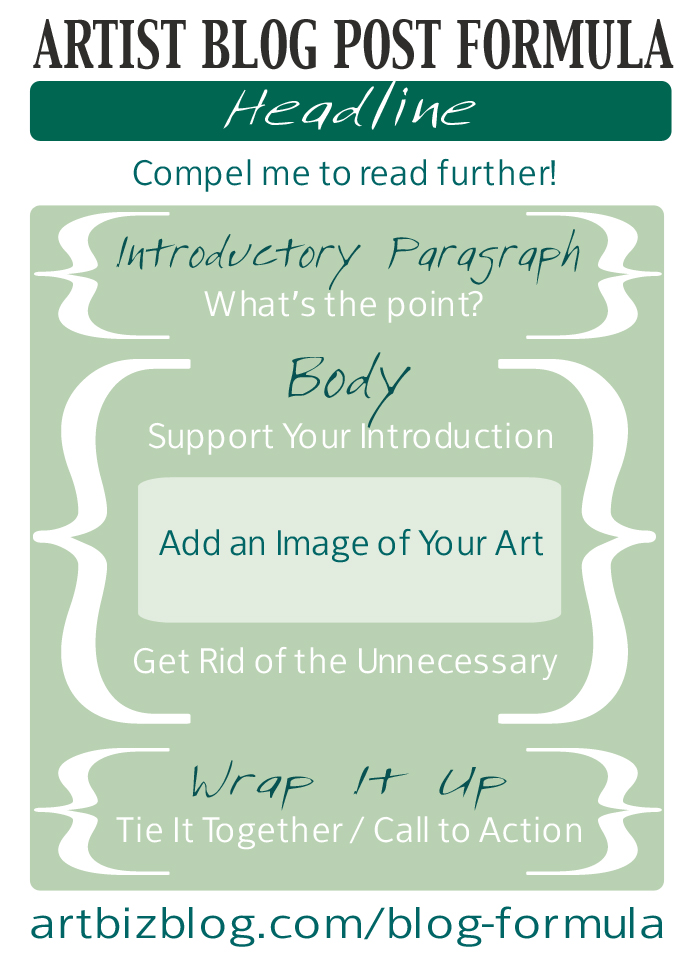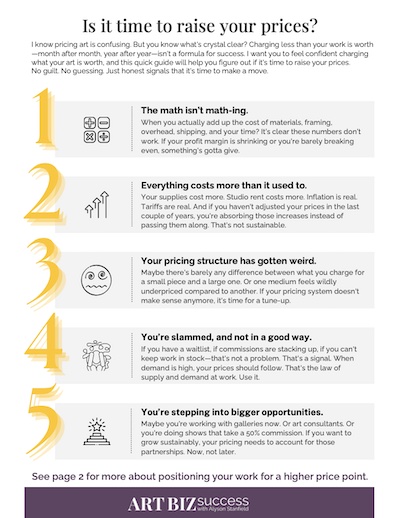Do you struggle with writing blog posts?
If you’re like a lot of artists we’ve had in the Blog Triage class, you blog because someone (probably me) told you it was a good idea. But you’ve never really gotten the hang of it.
You fight your way through blogging. You might have a good idea for a post, but it’s like jelly when you sit down to write because it has no form, no backbone.
Facing the blank screen with good intentions, you hack something out because it’s time to post. You need that post you promised.
“Alyson said this was supposed to be fun!” You whine.
Sometimes you have to write just to write. You have to get all of the crap out before you reach the genius nuggets. But you must get to the genius if your post is going to come together.
Ask yourself: What is the purpose of this post? With the purpose in mind, you can pull together the main components of your post.

Introductory Paragraph(s)
Your introductory paragraph should get straight to the point: What is your post about? Summarize it in a way that grabs our attention and compels us to read further.
My introduction to this article opens with a problem: “Do you struggle with writing blog posts?”
If blogging is easy for you, there’s no need to read further. If you answered Yes, you’re probably going to stick around because you’re relatively certain you might pick up some pointers to help you overcome this struggle.
Give your readers the same courtesy.
No rambling.
No hemming.
No hawing.
Write with purpose.
Body
Stay on topic!
Go back to your introductory paragraph and make sure you’re delivering what you promised. Get rid of anything that strays from the topic.
Henri Matisse said, “All that is not useful in a picture is detrimental.” The same could be said for your blog posts.
Every word or thought you include that doesn’t have to be there weakens your thesis.
Take out words like really, very, and other unnecessary modifiers. Condense lists of adjectives within sentences.
Image
Marketing gurus insist that images are becoming increasingly important on the Internet.
That puts you, a visual artist, at an advantage. Use it!
Upload an image or two of your art with every post. Make them large so they look primary rather than a decorative afterthought.
Don’t forget to add complete credit lines to image captions.
Conclusion | Call to Action
Bring your points back together at the end of your post and provide a call to action.
I often ask a question at the end of my post that encourages comments.
You might want people to click through to see an image, subscribe to your blog or newsletter, or attend an event. Your call to action should relate to the content of your post. See how I do that below.
Headline
Writing titles or headlines is, I believe, the most difficult step in writing a post. That’s because headlines are the most important part of the post. People aren’t going to look past a boring headline to see if there’s something of more interest.
Some people say, “Write the headline first.” Others prefer to wait until the end. I tend to be in the latter camp most of the time, but the headline for this post came before the content.
However you work best, don’t put your post out there with a wimpy headline.
Got it?
Use this formula to relax more about writing your posts. It never gets easy, but if you take your time and check to see that all of the pieces are in place, you’ll sprinkle words out into the world that you’re proud of.




8 thoughts on “Relax! This Blog Post Formula Does the Work for You [Infographic]”
I would add that you should also write your headline and opening paragraph for Search Engine Optimization. Learning how to do that will help bring more readers to your blog.
Gayle: That’s always a good idea, but I believe it’s far more important to write the headline for your readers – so that they’ll open it and pass it along. A good headline will do both. And they’re uber hard to write, IMHO.
Love that infographic! I already KNOW all the stuff you say but having that graphic to run my eye down as I sit down to write is just perfect! Thanks 🙂
Glad to hear that, WildC.
Great tips and I love the visual too. Thanks!
This is a great post for demonstrating a GREAT POST!! Terrific graphic.
I learned soooo much from you and Cynthia in Blog Triage 2010…and I thank you everyt week when I sit down to blog…(though don’t look I’m a few days late ‘-)
yet…I’m feeling the urge to jump back in for a refresher and a jump-start. It’s been some time since I’ve migrated to Word Press and ***I still have so much to learn***.
LOVE Blog Triage!!
Pingback: Should Your Older Art Be Put Out to Pasture? — Art Biz Blog
Hi Alyson
This is fab, I do struggle to keep on-topic when I write my blogs and so this is really handy. I have printed a copy and it’s on the pin board next to my computer. A colleague and I are planning a two person exhibition in October and we are organising it all ourselves from choosing the gallery, to raising funds, marketing and publicity and inviting guests. I’d like to blog the whole process to when the show opens in October. Wish us luck!
Anne